Sulphides: Cinnabar
 Diagnostic card.
Diagnostic card.
In the photo - twinned crystals of cinnabar bright red in calcite
Hg S (mercuric sulphide)
The trigonial trigonometric system
Hardness 2-2,5
Specific weight 8.1
Cleavage is perfect
Rough fracture
Color red
Color in powder red
Glitter diamond
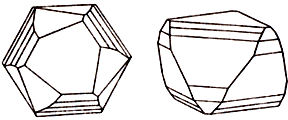
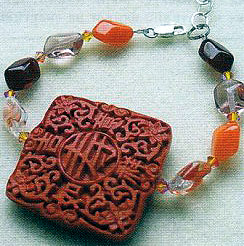 Cinnabar is a mercury sulphide. The shine is diamond or dim, it only shines through thin cleavages. Colors: from red to brownish-red, gray areas. The dash is red. The fracture is uneven, stepped. It's fragile. Cleavage is perfect.
Cinnabar is a mercury sulphide. The shine is diamond or dim, it only shines through thin cleavages. Colors: from red to brownish-red, gray areas. The dash is red. The fracture is uneven, stepped. It's fragile. Cleavage is perfect.
Occurs in low-temperature hydrothermal deposits. Crystals (trigonal syngony) are thickly-tabular, rare. Usually it forms dense aggregates, granular or draining. The most important ore of mercury. Places of distribution: Spain, Italy, Yugoslavia, USA, Japan, China.
The mineral crystallizes in the trigonal system, very rarely in the form of individual individual crystals. Usually it is observed in the form of crystalline or earthy masses or as a raid. Has a distinctive bright red color. Luster diamond on fresh surfaces of cleavage of elongated crystals; But in earthy aggregates it appears weakly. Powdered cinnabar keeps its characteristic intense red color. Psychotropic poison (bad dreams). Another name for the mineral is cinnabarite.
Diagnostic signs.
When heated to a temperature above 580 ° C, the cinnabar melts, releasing droplets of mercury. The mineral is easily scratched by the knife blade; Very heavy, brittle, with perfect cleavage.

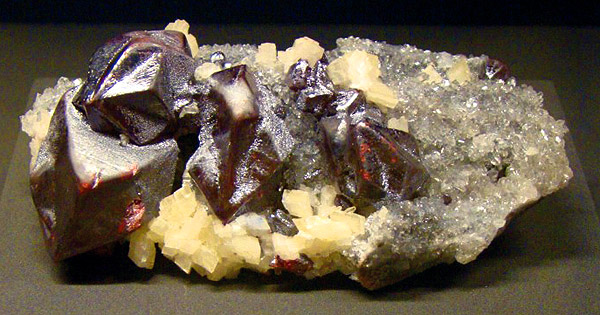
Scepterlike twins of the red cinnabar. Dolomite, quartz. Wanshan, Guizhou, China.
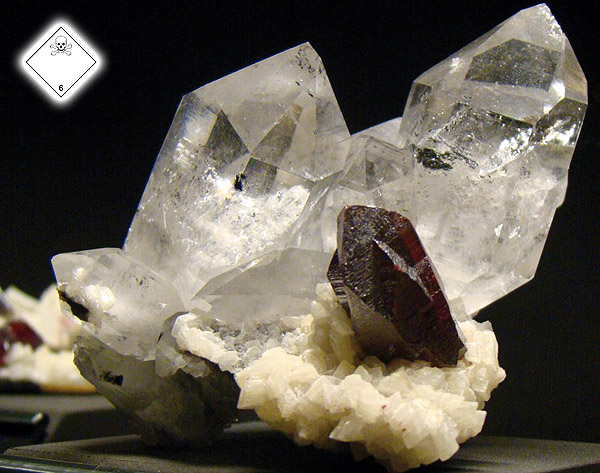
Double cinnabar on the cluster of quartz crystals. Wanshan, Guizhou, China. (2011).
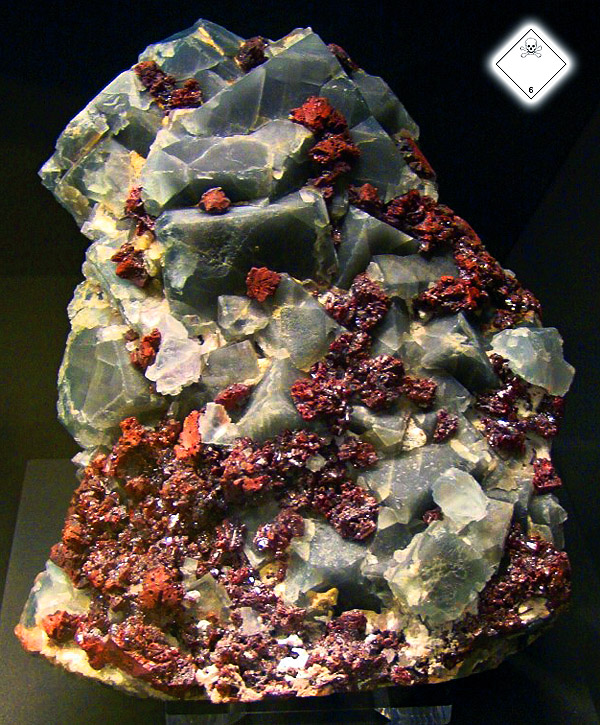
Cinnabar, fluorite. Chauvai, Kyrgyzstan (Fergana, Central Asia, CIS).
Origin.
Cinnabar has a hydrothermal excitatory genesis. It is formed during cooling and consolidation of residual magmatic fluids (sulfur and mercury) after the crystallization of granites and pegmatites. It occurs in the form of veins, crusts and inclusions in rocks of various types, primarily in limestone and clayey rocks, but also in lavas directly associated with manifestations of volcanism. Sometimes occurs in placers (sedimentary deposits formed as a result of the destruction of ancient rocks containing this mineral), where it is concentrated due to its high specific gravity.
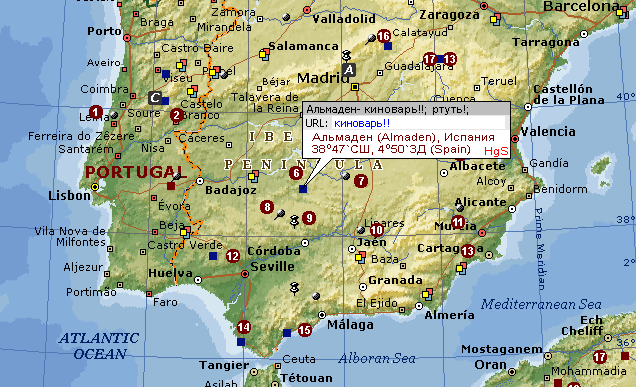

Map-scheme of the passage and location of the largest industrial depository of cinnabar - Almaden
Almaden (Altnaden) is a mercury deposit in Spain (EU), the world's largest and unique in quality of ores. Developed since the 1st millennium AD. It is located on the southern wing of a large (60x40 km) Shilon syncline, composed of Lower Paleozoic schists with three packets of quartzites, mineralized. The main deposit is confined to one of these packs - to the place of its tornado-shaped bend, complicated by an oblique fracture. The ore-bearing tutu (40-60 m) contains three ore quartzites converging at the depth of the ore (4-12 m) - three levels of kimberlite, to the karst. The fall of the beds is almost vertical. A steeply dipping ore kimberlite column is exploited (about 50 years). Its length on the surface is 650 m, at a depth of modern working (508 m) - 450 m. Goes to magma - a constant dry sublimation of mercury, sulfur and cinnabar formation.

Space object (galaxy, photo from the outer side of the funnel-tornado base)

Computer processing of this gas object, which resembles a stone tornado of Spain
Modeling on a computer in the vicinity of Madrid in order to identify a similar space structure
Recolouring the space structure from blue-blue to brown terracotta
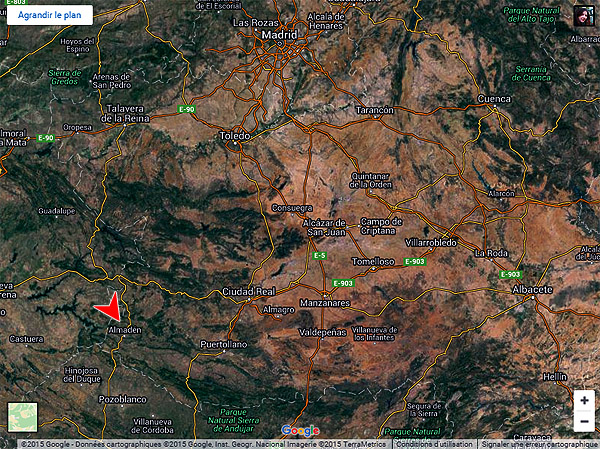
The city of Almaden and its location on the map of Spain, the EU (Google imagery, 2015)
The neighborhood of Madrid (Spain, EU), the gaze and the steps - resemble a stone inferno-tornado
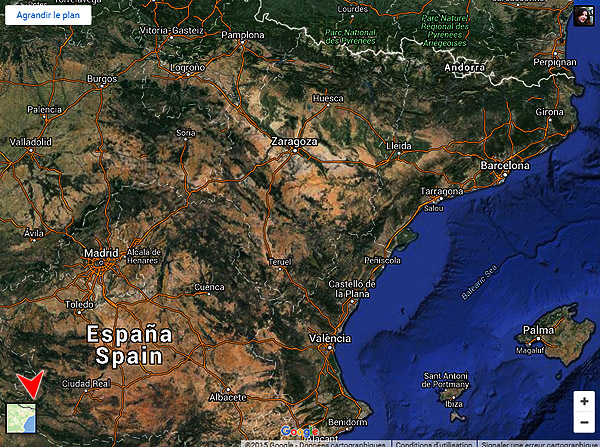
The general survey of the territory of Spain, the EU - the hill, the area of the location of the cinnabar field
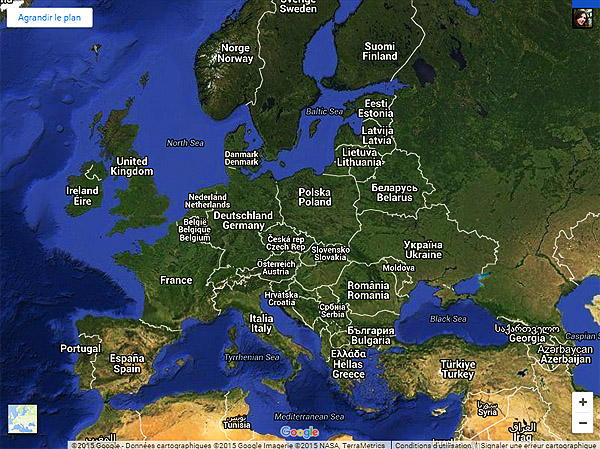
From Spain, the EU to Ukraine (CIS), the port of reception of cinnabar - the city of Nikolaev, the Black Sea (CIS)
There is a similarity of the southeastern coast of the Mediterranean Sea of Spain, the EU and the Crimea (in miniature)
The neighborhoods of Madrid and Spain (EU) resemble a stone tornado galaxy in miniature
The ores are massive, dense; Besides cinnabar contain a noticeable amount (up to 1/20) of native mercury. With depth, the mercury content decreases (%), water goes: 30-20, 18-12, 7-5, 4-3, at the active horizon 2-1. About 500 thousand tons of metal were mined. Maximum annual production up to 2.5 thousand tons; In the 80-ies. XX century. Production ranges from 1.2-2.0 thousand tons. The remaining reserves are estimated at 250 thousand tons. Production is carried out in mines. The development system is ceiling-recessed with selective excavation of rich parts of ore deposits (at the hanging side). Roofs and walls of operational excavations (cross-section up to 10x3 m) are fixed by an anchor support and covered with a protective net with their simultaneous cementation. Native mercury, flowing to the soil of excavations, is collected separately. Renewable (on the catalyst, arsenic).
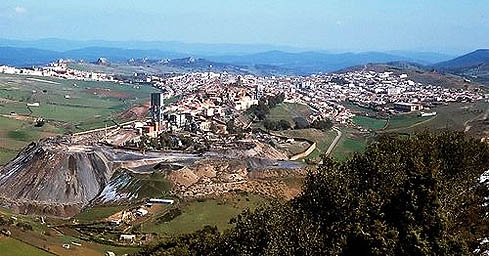

Place of Birth.
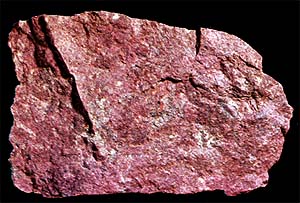 The most famous cinnabar deposits are Almaden in Spain (the norms of the Ukrainian police transporting dangerous goods - ADR N 9 - poison, skull and bones on a white-and-yellow background, in a rhombus, orange flashing light, night), Monte Amata in Tuscany, Idrija in Slovenia . This sulphide is present here in small massive accumulations and inclusions in lavas, limestones and other rocks. Deposits are identified in the USA - New Idria, New Almaden. Here, in the state of Arkansas, well-formed small crystals are also found. Of great importance are also Russian, Peruvian, Chinese and Algerian deposits.
The most famous cinnabar deposits are Almaden in Spain (the norms of the Ukrainian police transporting dangerous goods - ADR N 9 - poison, skull and bones on a white-and-yellow background, in a rhombus, orange flashing light, night), Monte Amata in Tuscany, Idrija in Slovenia . This sulphide is present here in small massive accumulations and inclusions in lavas, limestones and other rocks. Deposits are identified in the USA - New Idria, New Almaden. Here, in the state of Arkansas, well-formed small crystals are also found. Of great importance are also Russian, Peruvian, Chinese and Algerian deposits.
Application.
Since mercury in its pure form is a rarity, cinnabar is the most important industrial mineral for its production. Mercury is used for the production of various precision instruments and for amalgamation (gilding, gilding - dishes, etc.). In the past cinnabar was used as a pigment for the manufacture of red paint, but currently prefer synthesized cinnabar. Separate cinnabar crystals are rarely found. Most often the mineral is found in the form of granular aggregates. Although cinnabar is easy enough to melt, heating to 200 o C, but you can dissolve the stone only in a mixture of nitric and hydrochloric acids, known as "royal vodka".
The most famous cinnabar deposits are located in Spain (Almaden), Slovenia (Idrija, EU), Mexico and the USA (California, Oregon, Nevada). Among other countries that extract minerals are Kyrgyzstan, Austria, Italy, China, Ukraine (Donbass - Donetsk region, Priazovye, CIS). In Russia (Russia, CIS) cinnabar is mined in the Altai, Transbaikalia and Chukotka. Cinnabar is also one of the symbols of China. The bright red paint, made on the basis of the cinnabar, was also known in ancient Egypt. Back in the III century BC. Here, this mineral was used to color souvenirs. In ancient Russia cinnabar was used for the painting of icons. She also wrote capital letters in the Slavic manuscripts of the 11th-14th centuries. In Russia, the paint, made from cinnabar, was used for the painting of icons, on freshly cleaved cinnabar like blood stains. In air, it gradually oxidizes from the surface, becoming covered with a thin film of tarnish (HgO).
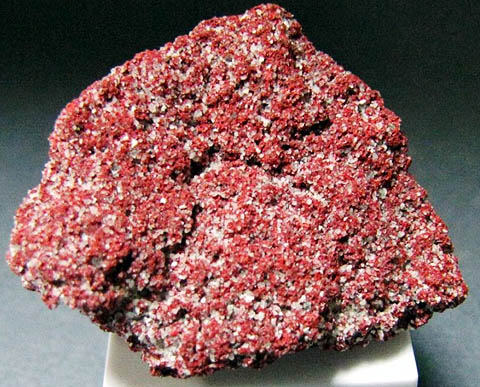
Cinnabar. Cerreto-Piano, Grosseto, Tuscany, Italy. Photo: © А.А. Evseev.
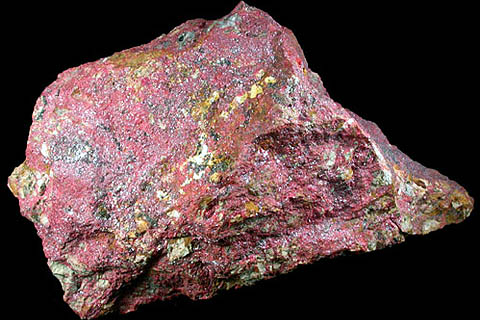
The cinnabar is red crystallized with small microcrystals.
New Almaden (New Almaden), California, USA.

Red Cinnabar hidden. Metatsinnabarit (octahedron crystal 3-5 mm) on the cinnabar (N 478)
Karginsky Island, Bering Sea, NE Coast of Kamchatka, Russia (RF, CIS). Photo: © А.А. Evseev.

Crystal red cinnabar - a dangerous stone of amnesia and oblivion
Place of Birth. Nikitovsky deposit. Ukraine
Nikitovskoye field is located on the territory of Donetsk region. Southeast of Ukraine, is developed and is famous for its remarkable cinnabar specimens, especially well-formed twin crystals and their intergrowths, sometimes in association with black needle antimonite. Cinnabar twins from this field are often distinguished by rare purity, and are translucent to almost transparent. Druzes of cinnabar crystals were also found on brushes of crystals of colorless quartz in cracks (volcanoes). One of the oldest in Ukraine mercury deposits - Nikitovskoe - is located in Donbass (Donetsk region, Gorlovka). Here, at various depths (up to 20 meters), ancient mining workings were discovered, in which it was possible to find tools - stone hammers.
Red cinnabar is the most important ore of a silvery, liquid earth under the mercury metal. The mineral has a beautiful bright red or brownish-red color, reminiscent of the color of blood (dangerous - you can confuse it with hematite "red head"). It is believed that the name of the stone goes back to the Greek "kinnobaris" - the blood of the dragon. In the works of Herodotus there is evidence that the Greeks exported red paint from the Azov Sea (Ukraine, CIS), where cinnabar production was carried out long before our eyes. The ancient Scythians (Ukraine, CIS) called this paint - "kinnabis" (a word from Australia). Proceeding from this, it can be assumed that the word "cinnabar" has both Scythian and foreign (for Ukraine, CIS) origin. There are also other names in the mineral: coral ore (Pacific Ocean), spherical ore, mercury blend, Chinese stone (Shan-Hai, China).
Nikitovsky deposit has a certain similarity with the detergents of Huancavelica in Peru and, New Almaden in the United States and the indigenous industrial deposit of cinnabar - Almaden in Spain, confined to silicified sandstones. Nikitovsky ore field is a stratiform formation of quartz-dickite-cinnabar type. The deposit is confined to the global system of dislocations in the Earth's crust - so-called. "The Karpinski lineament".
Thermobarogeochemical studies established a temperature range of mineralization processes in the interval 290-90 ° C. The nature of the waters of mineral-forming solutions and volcanic constituents (sulfur, etc.) is estimated by researchers as mixed with a significant participation in them of a deep juvenile-magmatogenic component (batholith), which was determined from the isotope characteristics of oxygen and hydrogen.

Sofiysky kr, Nikitovka, Donbass, Ukraine. Photo: © Ya. Kirillin. Installation: D. Tonkacheev, 2013
All the rich (non-industrial) ore sites are located within a strip stretched in a sub-latitudinal attack, these deposits are confined to the Gorlovka anticline of the east of Ukraine. Cinnabar mineralization in all deposits of the ore field is concentrated in silicified sandstones lying among clayey shales, and rich mineralization genetically gravitates toward large secant (oblique) cracks (similar to the type of multiple strictly-vertical cracks in the earth's crust, Almaden, Spain - on active volcanic effusive batholiths ).
| The name of a cargo that is particularly dangerous for transportation | room
UN |
Class
ADR |
| Natural cinnabar: Mercury (II) sulfide | 2025 | 6.1. |
| Mercury (II) Iodide | 1638 | 6.1. |
| Mercury (II) Cyanide | 1636 | 6.1. |
| Mercury (II) chloride, Mercury Dichloride | 1624 | 6.1. |
| Mercury | 2809 | 8 |
| Mercury GRIMATE HYDROGEN with a mass fraction of water or a mixture of alcohol and water of at least 20% | 0135 | 1 |
| Mercury CONNECTION LIQUID, NZK | 2024 | 6.1. |
| Mercury CONNECTION SOLID, NZK | 2025 | 6.1. |
| Mercury (II) sulfide (cinnabar) | 2025 | 6.1. |
| Mercury (I) chloride | 3077 | 9 |








ADR 6.1 (Ukraine, competence Wasteworthy cargo, military). Toxic substances. Risk of poisoning by inhalation, in contact with skin or if swallowed. Dangerous to the aquatic environment or sewer system. Use the mask for emergency leaving the vehicle. Call the police ("102").
ADR 8 . Corrosive (corrosive) substances. Risk of burns from skin corrosion. They can react violently with each other (components), with water and other substances. The substance that spilled / crumbled can emit a corrosive vapor. Dangerous to the aquatic environment or sewer system. Call to the police ("102"), metrology, sanitary-epidemiological authorities, district police inspector.
ADR 9 . Other dangerous substances and products. Risk of burns (mercury). Risk of fire (warming up). Risk of explosion (heating with water). Dangerous to the aquatic environment or sewer system. Call the police ("102").
Fish . Substances that are hazardous to the environment. Dangerous to the aquatic environment or sewer system. Do not pour into rivers, lakes, ponds, dry and irrigation channels, wells, etc. Housing and communal services.
A rhombus . A warning sign for the designation of goods vehicles that carry dangerous goods in limited quantities (packed and labeled according to ADR, Ukraine). The upper, lower corners and contour of the sign must be black. The central part is white or other contrasting color (yellow).
In the 1991-1992 gg. (Post-USSR) Nikitovsky Combine was declared bankrupt (refusals to work at the field), after which Nikitovskaya mercury (semi-industrial production), the Precision Materials Plant and the state owned steel were started on its basis. A company that deals with the hydro-protection of lands (environmental department of Donetsk) of the surrounding territories. Conducted in 2010-2012. The inventory of this Donbass deposit showed the presence of promising ore layers and sufficient mercury reserves for semi-industrial development. According to most experts, to revive the production of cinnabar and the production of mercury in this field is real.

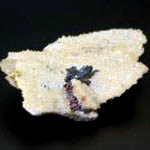
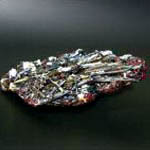

In 1995, 110 years have passed since the beginning of development of mercury ores of the Nikitovsky group of deposits in the Donbass (east of Ukraine). This anniversary, unfortunately, coincided with the halt of the operation of the Nikitovsky mercury mine. In its history, this is not the first time that mining work stopped for one reason or another - the 30s. XX century. (sabotage). After the resumption of work (type Almaden, Spain), along with the extraction of mercury, again appear in the market of state. Procurement of remarkable and unique industrial and museum samples available for contemplation (poison - transportation in sealed containers, ADR dangerous cargo N 6, 9, etc.).
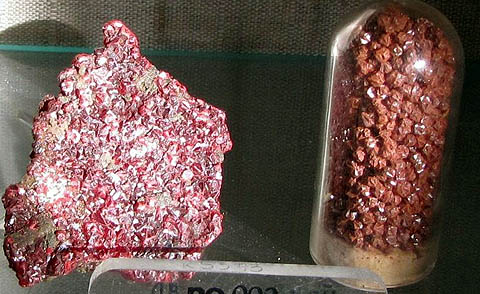
Cinnabar (similar to flowers and fruits of the Physalis plant - crystals in a flask).
Nikitovka, Donbass, Ukraine (ex-USSR). Photo: © А.А. Evseev.
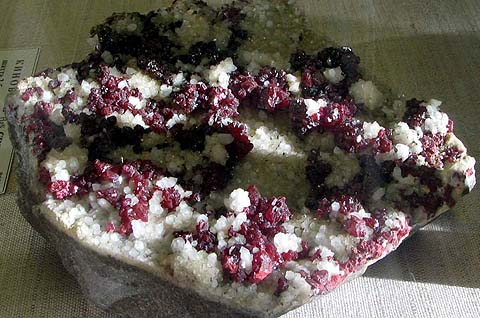
Cinnabar. Nikitovka, Donbass, Ukraine. Photo: © А.А. Evseev.
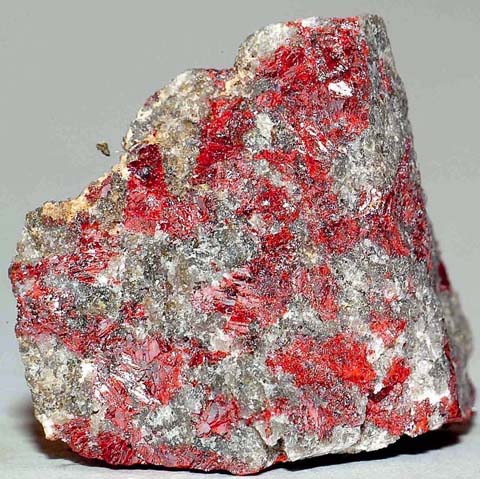
Cinnabar. Nikitovka, Donbass, Ukraine. 30 mm. Photo: © N.A. Colt
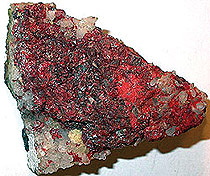 Since ancient times mercury sulfide sulfide - cinnabar (crystals, druses and stratum) served as the raw material for the production of mercury. The mining of cinnabar in ancient mines was conducted in abnormal conditions. The miners died from dehydration and poisoning in pairs of mercury, sulfur and cinnabar. In the mine workings, where cinnabar was extracted in ancient times, archaeologists find not only tools of miner's work (stone hammers, wedges), but also skeletons of those killed in violation of the rules for exploiting the deposits (breathed sulfur and mercury).
Since ancient times mercury sulfide sulfide - cinnabar (crystals, druses and stratum) served as the raw material for the production of mercury. The mining of cinnabar in ancient mines was conducted in abnormal conditions. The miners died from dehydration and poisoning in pairs of mercury, sulfur and cinnabar. In the mine workings, where cinnabar was extracted in ancient times, archaeologists find not only tools of miner's work (stone hammers, wedges), but also skeletons of those killed in violation of the rules for exploiting the deposits (breathed sulfur and mercury).
No less dangerous is the ancient technology of extracting mercury from ore. Cinnabar was stacked in clay pots, which were installed in a chamber lined with bricks (Almaden, Spain, west of Europe). Next to the pots were branches of trees with fresh foliage (and ash, condensation on charcoal). When the cinnabar was heated in clay pots, mercury began to evaporate. The vapors passing through the leaves condense and settle on them. Weighed down from the mercury "dew" branches shook in a special dish.
The Bustamente furnace (pictured as a cinnabar, Spain, west of Europe ) was considered quite a perfect way: from below, the fire was fired, the ore was poured higher and the catalyst was poured - coal (C - carbon), when the mixture was heated, the mercury evaporated and fell into the "refrigerator" Folded from ceramic vessels without a bottom (ashes and coal are needed - catalysts). There mercury condensed, drained into a central open trough and through it fell into the receiver of mercury. Below is a model of an older and less perfect furnace (an artisan method of obtaining cinnabar), the Mercury Museum (this oven is "Russian" and sung in the epos of Moldova and the Russian Federation, "cakes with cinnabar").
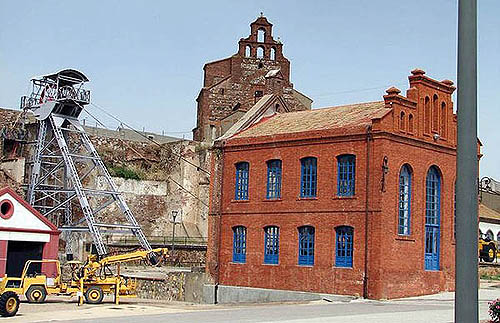
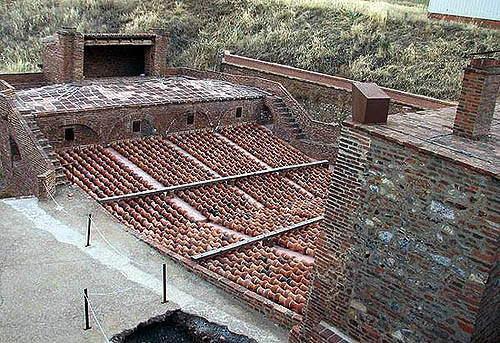

In many countries cinnabar has long been used as a red pigment (the Russian Bibles, monasteries, restoration). One of the most popular colors was in Ancient Russia (Russia). Cinnabar is distinguished by a brighter and more saturated color. In the workshops of ancient painters, along with the cinnabar - stone loss of memory (amnesia), often supplied and mercury - an aphrodisiac for women (when heated).
The treatise describes the preparation of the cinnabar: "If you want to make a cinnabar, take the sulfur, which is available in three forms: white, black (coal, bitumen) and saffron-yellow, rub saffron-yellow sulfur on a dry stone and add to it two parts of mercury Weighing everything on the scale, when everything is well rastered, put the mixture in a glass jar, close the hole tightly so that the smoke does not evaporate, rub the vessel on all sides with clay, and put it on the fire to dry. Move it to the burning coals, and when it It's heated, then you hear inside the noise - it combines mercury with burning sulfur.When the sound stops, remove the vessel from the fire, open it and take out the paint. "
Cinnabar is the most common mineral of mercury. It forms in hydrothermal near-surface deposits, together with quartz, calcite, barite, antimonite, pyrite, galena, marcasite, less often with native mercury and with native gold (dry sublimation, the richest in metal ores - dry sulfides). Cinnabar is often deposited in veins among the highly metamorphosed jasperoid rocks associated with recent volcanic activity and alkaline hot springs.
Placer cinnabar is a subordinate industrial type of mercury; Independent large-scale residual eluvial-slope placers, spoon and alluvial placers of near-bottom demolition, as well as gold-bearing placers with cinnabar from which the latter is extracted in passing, are of independent industrial interest. Residual placers of cinnabar are most common in the areas of development of the chemical weathering crust, where they are confined to "red clays" (lithosphere kimberlite) - laterite weathering crust formations. Small, but very rich clusters of cinnabar are confined to eluvial and deluvial deposits in karstic funnels and cavities.
In the temperate and high latitudes, there are eluvial-slope placers of cinnabar, associated with coarse clastic debris on the slopes and interfluves within the ore field (Chukotka). They have the appearance of reservoir deposits up to 3 m in thickness and contain cinnabar in fragments with quartz (native mercury is also found). In spoon and alluvial placers cinnabar is accumulated both in the form of grains and well-rounded pebbles, composed of dense massive differences. Its main mass is concentrated on the dam (kimberlite); The length of these placers is 1-2 km, the reservoir thickness is 0.2-3 m; They are usually closely interfaced with the indigenous sources that emerge at the bottom of the valleys, and are single-stranded deposits of a striated or nested structure. Placer cinnabar is known in North America, the USA (New Almaden), Yugoslavia (Avala), and the Northeast of the Russian Federation (CIS). Age placers cinnabar Pliocene-Quaternary; In the North-East of the Russian Federation (CIS), buried alluvial placer cinnabar was found in the marginal parts of seaside hollows (Primorye, Pacific Ocean).
Of the numerous deposits of Central Asia, the largest is Khaidarkan in Kyrgyzstan. Also Chauvai (Kyrgyzstan) and Adrasman (Tajikistan). In Central Asia, other mercury deposits have also been developed. Thus, for example, inscriptions in the palace of the ancient Persian kings of the Achaemenids (6th-4th centuries BC) in Susa indicate that the cinnabar, which at that time was used mainly as a dye, was brought here from the Zeravshan Mountains located on the territory of modern Republics of Tajikistan and Uzbekistan. Apparently, cinnabar was mined here in the middle of the first millennium BC. In Russia, a large deposit is known in Chukotka. Pliny the Elder mentions in his writings that Ancient Rome bought in Spain annually up to 4.5 tons of mercury.
Poisonous and radioactive dangerous stones and minerals
** - poisonous stones and minerals (mandatory check in the chemical laboratory + explicit indication of toxicity)
** - radioactive stones and minerals (mandatory check on the standard dosimeter + ban on open sales in case of radioactivity exceeding 24 milli / g / h + additional measures of population protection)
Catalog of minerals and semi-precious stones of the world by groups
** - poisonous stones and minerals
** - radioactive stones and minerals


Comments
Commenting on, remember that the content and tone of your message can hurt the feelings of real people, show respect and tolerance to your interlocutors even if you do not share their opinion, your behavior in the conditions of freedom of expression and anonymity provided by the Internet, changes Not only virtual, but also the real world. All comments are hidden from the index, spam is controlled.